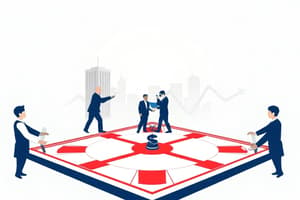Podcast
Questions and Answers
What is the defining characteristic of a firm with market power?
What is the defining characteristic of a firm with market power?
- The ability to lower prices below average cost.
- The ability to operate without any fixed costs.
- The ability to perfectly price discriminate.
- The ability to raise price above marginal cost without fear of other firms entering the market. (correct)
A pharmaceutical company holds a patent for a life-saving drug. What economic advantage does this patent primarily confer?
A pharmaceutical company holds a patent for a life-saving drug. What economic advantage does this patent primarily confer?
- It gives the company the legal right to be the sole producer, thus creating market power. (correct)
- It eliminates the need for the company to engage in any research and development.
- It forces the company to sell the drug at marginal cost.
- It guarantees that the company will maximize social welfare by producing the drug at the lowest possible cost.
To maximize profits, at what level of output should a firm with market power produce?
To maximize profits, at what level of output should a firm with market power produce?
- Where marginal cost equals marginal revenue. (correct)
- Where average revenue equals average cost.
- Where total revenue is maximized.
- Where marginal cost equals price.
Why is the marginal revenue (MR) curve below the the demand curve for a firm with market power?
Why is the marginal revenue (MR) curve below the the demand curve for a firm with market power?
If a monopolist decreases the price of its product from $16 to $14, and as a result, quantity demanded increases from 2 to 3 units, what is the marginal revenue of selling the third unit?
If a monopolist decreases the price of its product from $16 to $14, and as a result, quantity demanded increases from 2 to 3 units, what is the marginal revenue of selling the third unit?
What is the correct way to express the shortcut formula for marginal revenue if the demand is expressed as: $P = a - b \times Q$?
What is the correct way to express the shortcut formula for marginal revenue if the demand is expressed as: $P = a - b \times Q$?
A monopolist is producing at a level where marginal cost exceeds marginal revenue. To increase profits, the monopolist should do what?
A monopolist is producing at a level where marginal cost exceeds marginal revenue. To increase profits, the monopolist should do what?
What 'effect' makes the demand for pharmaceuticals inelastic?
What 'effect' makes the demand for pharmaceuticals inelastic?
What is a key difference in outcome between a monopoly and perfectly competitive market?
What is a key difference in outcome between a monopoly and perfectly competitive market?
What is the primary implication of deadweight loss due to monopoly?
What is the primary implication of deadweight loss due to monopoly?
How can monopolies be especially harmful to the economy?
How can monopolies be especially harmful to the economy?
In what way, if any, can monopolies create benefits?
In what way, if any, can monopolies create benefits?
Why would a firm be unlikely to spend on research and development without patents?
Why would a firm be unlikely to spend on research and development without patents?
What are the factors that can present barriers to entry?
What are the factors that can present barriers to entry?
What defines source of monopoly power called 'economies of scale'?
What defines source of monopoly power called 'economies of scale'?
What is a 'natural monopoly'?
What is a 'natural monopoly'?
Which of the following contributes to network effects?
Which of the following contributes to network effects?
What is a price control, as opposed to government ownership or antitrust law, and how can it affect a monopoly?
What is a price control, as opposed to government ownership or antitrust law, and how can it affect a monopoly?
Why might reducing prices through regulation decrease a company's incentive to innovate?
Why might reducing prices through regulation decrease a company's incentive to innovate?
What are the primary U.S. antitrust laws?
What are the primary U.S. antitrust laws?
Flashcards
Market power
Market power
The power to raise price above marginal cost without fear that other firms will enter the market.
Monopoly
Monopoly
A firm with market power.
Marginal revenue (MR)
Marginal revenue (MR)
The change in total revenue from selling an additional unit.
Marginal cost (MC)
Marginal cost (MC)
Signup and view all the flashcards
Economies of scale
Economies of scale
Signup and view all the flashcards
Natural monopoly
Natural monopoly
Signup and view all the flashcards
Barriers to entry
Barriers to entry
Signup and view all the flashcards
Network Effects
Network Effects
Signup and view all the flashcards
Innovation
Innovation
Signup and view all the flashcards
Antitrust laws
Antitrust laws
Signup and view all the flashcards
Price Controls
Price Controls
Signup and view all the flashcards
Study Notes
- Monopoly is Chapter 13
Introduction
- AIDS has killed more than 40 million people since 1981
- Deaths from AIDS in the US dropped 50% between 1995 and 1997 because of Combivir and similar drugs
- Combivir pills cost $0.50 to produce, but are sold for $12.50, which is 25x higher
Definitions
- Market power is the power to raise price above marginal cost without fear that other firms will enter the market
- Monopoly as a concept is a firm with market power
- Marginal revenue (MR) is the change in total revenue from selling an additional unit
- Marginal cost (MC) is the change in total cost from selling an additional unit
Market Power
- GlaxoSmithKline (GSK) owns the patent on Combivir
- Patents give exclusive rights to make, use, or sell a product
- GSK's patent for Combivir prevents competition, giving GSK market power
- India does not recognize the Combivir patent
- In India, an equivalent drug sells for $0.50, or the marginal cost
- To maximize profit, firms produce at the level of output where MC = MR
- Firms with market power must lower prices to sell an additional unit
- Firms with market power face a downward-sloping demand curve
- Additional revenue per unit < current price, i.e. MR < P
Marginal Revenue
- When the price drops from $16 to $14, quantity increases from 2 to 3 units
- Total revenue increases from $32 to $42
- Marginal revenue, or the change in total revenue, is $10
- The MR begins at the same point on the vertical axis as demand
- MR has twice the slope
Monopoly Maximization
- Monopoly maximizes profit by achieving MR = MC at 80 million pills
- Profit-maximizing price is $12.50
- Profit per pill is $10.00
- Total profit is $10 x 80, totaling $800 million
Elasticity
- Two effects make demand for pharmaceuticals inelastic
- The "you can't take it with you" effect occurs because people with serious illnesses are relatively insensitive to the price of life-saving drugs
- The "other people's money" effect says if third parties are paying for the medicine, then people are less sensitive to price
- The more inelastic the demand curve, the more a monopolist will raise price above MC
Deadweight Loss
- Monopolies charge a higher price and produce less than competitive firms
- Monopolies reduce total surplus (consumer surplus + producer surplus)
- A deadweight loss occurs because sales do not occur because the monopoly price is above the competitive price
Corruption and Inefficiency
- Many monopolies result from government corruption
- Tommy Suharto, the Indonesian president’s son, was given the clove monopoly
- He bought the Lamborghini company with the monopoly profits
- Monopolies are especially harmful if they control a good that is used to produce other goods
- In Algeria, a dozen army generals each control a key good
- The generals are referred to as General Wheat, General Tire, etc, each trying to get a larger share of the economic pie
- Results is greater deadweight loss, and the "pie" shrinks
Incentives for Research and Development
- Drug prices are lower in India and Canada, due to India not offering strong patent protection and Canada controlling drug prices
- It costs over $1 billion to develop a new drug
- Patents are one way of rewarding research and development (R&D)
- Without patents, firms would not spend on R&D, and fewer new drugs would be developed
- Prizes can reward R&D without creating monopolies
- Patent buyouts are another alternative
- Buyouts reduce price without reducing R&D
- Government must raise taxes to pay for the patent, but it may be difficult to determine a price
Monopoly Power Sources
- Monopoly power arises from economies of scale, barriers to entry, network effects and innovation
- Economies of scale are the advantages of large-scale production that reduce average cost as quantity increases
- Natural monopoly occurs when a single firm can supply the entire market at a lower cost than 2+ firms can
- Monopolies arise naturally when economies of scale allow a single firm to produce at a lower cost than can many small firms
- Utilities like water, natural gas, and cable television are often natural monopolies
- If economies of scale are large enough, price can be lower under a natural monopoly than under competition
- Barriers to entry are factors that increase the costs to new firms entering an industry
- Potential barriers to entry include: ownership of an input hard to duplicate, brands and trademarks, and the development of a relationship with the market
- Network effects occur when products/services are more valuable as number of users increases
- Facebook has few competitors because everybody uses it
- There are only a few credit card companies because customers want cards widely accepted and firms want to accept cards widely used
- Innovation can lead to products that other firms cannot immediately duplicate
- Innovation involves a trade-off as iPhones are priced higher, but Apple would have less incentive to innovate if it didn’t expect monopoly profits
Regulation
- The government has many tools to regulate monopolies, including price controls, government ownership and antitrust law
- Price controls on a monopoly can increase output
- Reducing monopoly prices increases output/consumer surplus while decreasing the incentive to innovate
- Government ownership and regulation of electricity has provided the US with cheap power for decades
- Around 2/3 of the 3,000 electric utilities are government-owned
- Without competition or profit motive, there is a tendency to become inefficient
- Without regulation, providers can exploit market power
- Antitrust laws are antimonopoly laws
- The Sherman Act (1890) and the Clayton Act (1914) are 2 important U.S. antitrust laws
- These laws give the government legal authority to prosecute monopolies or firms’ attempts to monopolize, break up monopolies, prohibit mergers, and prevent acts that reduce competition
- Prices, technology, and market conditions are constantly changing, and firms grow, shrink, split, and merge
- Mergers lead to efficiencies of scale but also more market power
- Authorities must try to balance lower costs with higher prices
Studying That Suits You
Use AI to generate personalized quizzes and flashcards to suit your learning preferences.




